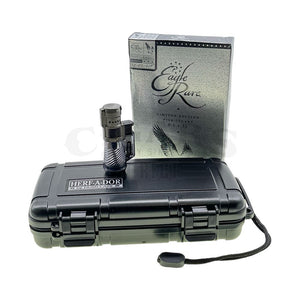How Lighters and their Components affect Cigar’s Taste and Experience
Cigar smoking is a sensory journey that covers taste, aroma, and the overall experience. Lighting a cigar is the first step in this rewarding journey. So, the right choice of lighter can affect the flavor and enjoyment of the smoke in a big way. From soft flame lighters to torch lighters and cedar spills, each type has its own components and features that can influence the nuances of a cigar's taste and aroma.
The Role of Lighters in Cigar Smoking
For both seasoned aficionados and newcomers to the world of cigars, the act of lighting a cigar is more than just a practical step – it's a ritual that sets the stage for the entire smoking experience. The right choice of lighter can enhance the flavors and aromas of the tobacco, while the wrong one can mar the experience with undesirable tastes and odors.
Different Lighter Types and Their Components
- Fluid Lighters: These lighters are commonly used and are affordable. Fluid lighters are a must-have for many smokers. However, some cigar enthusiasts continue to be concerned about the probable tainting of the cigar's flavors because of the variety of fuels used in them. For instance, Zippo lighters, which are a type of fluid lighter, contain different types of fuel, introducing the risk of intense odors which can affect the cigar's taste. To lessen this, one needs to hold the flame further away from the cigar and slowly light the tobacco. This can help reduce the risk of unpleasant odors.
- Gas Lighters (Butane Lighters): These types of lighters are the preferred choice for seasoned and experienced cigar smokers. Butane lighters offer the advantage of an odorless and tasteless flame and make them an excellent option when preserving the purity of the cigar's flavors takes top priority. The one negative of gas or butane lighters is the risk of running out of fuel.
- Matches: The good old matches, whether traditional or long ones specifically meant for lighting cigars, are not only an affordable choice but are also a popular backup choice for cigar enthusiasts. But the sulfur content found in match heads can impact the cigar's taste and aroma to a great extent. To lessen the impact of sulfur in the cigar smoking experience, one needs to wait until the flame has burned through the head and down to the wood before lighting the cigar.
- Torch Lighters: These types of lighters are Ideal for outdoor smoking. Torch lighters are wind-proof and generate a high-temperature and concentrated flame. This also means that the cigar foot can get heated up quickly and will require the cigar smoker to pay special attention not to let the flame scorch the tobacco. Having said that, torch lighters are ideal for windy conditions and any outdoor cigar smoker’s favourite lighter.
- Soft Flame Lighters: These are not very common and produce a cooler flame. As a result, they take longer to light the cigar. Thanks to their cool flame, however, the soft flame lighters reduce the risk of pervading the cigar with fuel flavors and offer a unique sensory experience. Just the right kind of lighter for those who like to go for a more traditional lighting method.
- Cedar Spills: They are known for their mild, aromatic flame. Cedar Spills will increase the cigar's aroma subtly without overriding the original flavor.
Ultimately, the choice of lighting methods, such as cedar spills, soft flame lighter, matches or butane torch lighters, depends on one’s own choice and what experience the cigar smokers expect from their most favourite stogie.
The Act of Lighting a Cigar
Well, it is more than just the simple and physical act of lighting it; it is a ceremony of sorts that pays tribute to the cigar as a complete entity comprising the wrapper, binder, and filler. To savor your stogie in all its glory, sticking to these guidelines can go a long way in giving you the perfect smoking experience.
- Close but not so close: When lighting a cigar, it's important to approach the flame with respect and avoid putting the cigar directly into the fire. Instead, keep it close to the flame without touching it. Don't make the mistake of immersing the cigar in the flame like you might with a cigarette, as this can cause overheating and ruin the delicate flavors of the cigar.
- A Deliberate Angle: Hold your cigar at an angle of 45 degrees to the flame. Slowly rotate the cigar and let the flame enclose the end.
- The Inaugural Puff: Take the first drag with a feeling of excitement.
To summarise, whether it's the precise control of a butane torch lighter, the traditional charm of a cedar spill, or the convenience of a gas lighter, the choice of lighter becomes an integral part of the cigar aficionado's cigar lighting ritual and determines the quality of every single puff of a well-crafted cigar.















